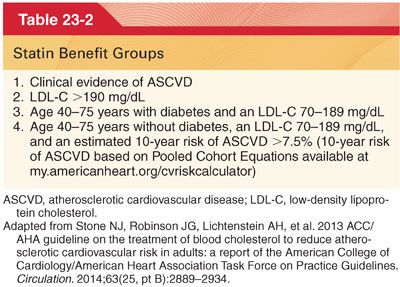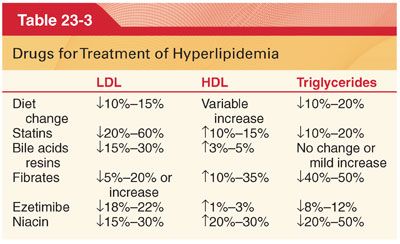
II. Lipid Disorders
A. Familial hypercholesterolemia arises from a defect in the gene for low-density lipoprotein receptors (LDL-R). Heterozygotes for this defect experience accelerated atherosclerosis and represent about 1 in 500 persons.
B. Hyperlipidemia may also arise from secondary causes including obesity, diabetes, alcohol abuse, hypothyroidism, glucocorticoid excess, and hepatic or renal dysfunction.
C. Most cases of hyperlipidemia in adults arise from a combination of secondary causes, genetic predisposition, and environmental factors, including poor diet and a lack of exercise.
D. It has been recognized for several decades that increased plasma concentrations of total and LDL cholesterol are associated with an increased risk of cardiovascular disease. Conversely, higher high-density lipoprotein (HDL) cholesterol levels appear to reduce the risk of atherosclerosis and cardiovascular events because of the critical role of HDL in reverse cholesterol transport. The safety and efficacy of 3-hydroxy-3-methylglutaryl coenzyme A reductase (HMG-CoA reductase) inhibitors, or statins, have been particularly well established (Table 23-2).

III. Drugs for Treatment of Hyperlipidemia (Table 23-3)

A. Statins are drugs that act as inhibitors of HMG-CoA reductase, the enzyme that catalyzes the rate-limiting step of cholesterol biosynthesis in which HMG-CoA is converted to mevalonate (see Fig. 23-1). The drugs in this class (atorvastatin, fluvastatin, lovastatin, pravastatin, simvastatin, and rosuvastatin) are considered equivalent and relatively free of side effects. Randomized clinical trials have shown that statins lower cardiac events in patients with or without atherosclerosis. The reduction in cardiac events observed with statin use may not be only secondary to the LDL lowering effects. Statins are thought to stabilize existing atherosclerotic plaques and there is evidence that statins have many pleiotropic effects, including antiinflammatory, antioxidant, and vasodilatory properties.
1. Pharmacokinetics
a. Statins are variably absorbed from the gastrointestinal tract following oral ingestion.
b. Lovastatin and simvastatin are prodrugs that require metabolism to the open β-hydroxy acid form to be pharmacologically active.
c. All of the statins are highly protein bound with the exception of pravastatin.
d. Except for pravastatin, all of the statins undergo extensive metabolism by hepatic P450 enzymes.
2. Side Effects. Statins are usually well tolerated with the most common complaints being gastrointestinal upset, fatigue, and headache.
a. Muscle-Related Adverse Effects. The most common adverse side effects from statins are skeletal muscle related (can range in severity from simple myalgias to myositis with mild creatine kinase elevation to life-threatening rhabdomyolysis) (Table 23-4). Myopathy appears to be most frequent in patients treated with simvastatin and lovastatin. Drugs likely to be administered during anesthesia, including succinylcholine, have not been shown to increase the incidence of statin-induced myopathy.

Stay updated, free articles. Join our Telegram channel

Full access? Get Clinical Tree


